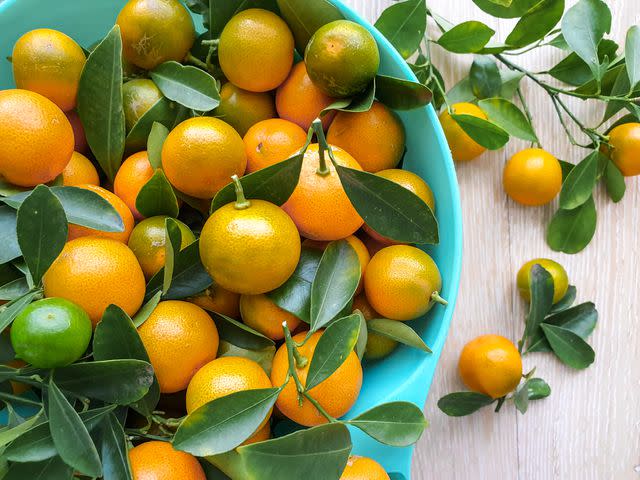What Is Calamansi?
It’s the secret ingredient in countless Filipino dishes.
Calamansi is what defines many Filipino dishes. I grew up with calamansi trees that my father planted in our backyard in the Philippines. Every day, dad would make us fresh calamansi juice mixed with sugar and water and put the chilled tumbler in our lunchboxes for school.
Whether it’s served as a chilled glass of freshly-squeezed citrusy juice or in a dipping sauce combined with salty soy sauce, calamansi is a versatile citrus fruit. Native to the Philippines, it’s popular in Filipino cuisine but can be used in a variety of ways.
Fast Facts
Origin: The Philippines
In season: Mid-August through October
Flavor notes: Sweet and sour citrus
Commonly used: In Filipino cooking and Asian dishes
What Is Calamansi?
Calamansi, also known as Philippine limes, are small round citrus fruits with green or dark yellow-orange skin measuring about an inch in diameter. Calamansi (citrus macrocarpa), also known as calamandin, calamondin, and kalamansi, is botanically a unique citrus plant. The calamansi tree is small, spiny, and 4 to 6 meters tall, with green elliptic, oblong leaves.
Native to the Philippines, calamansi also grows in Asian regions like Southern China, Taiwan, Borneo, and Indonesia. In the United States, it is cultivated in the warm climates of the west coast, Florida, Arizona, Hawaii, and in U.S. territories like Guam.
In Philippine cuisine, calamansi neutralizes the saltiness of patis (fish sauce) or soy sauce served on the side of different noodle dishes, grilled seafood, and vegetables. As an ingredient, calamansi enhances the flavors of popular Asian recipes.
Read More: A Guide to Citrus Fruits

Simply Recipes / Getty Images
What Does Calamansi Taste Like?
It has similar flavors to a mandarin orange but is as sour as much as it is sweet. The calamansi has a distinct sugary citrus scent—an orange-like aroma with a hint of lime. The juice is tart and lightly sweet.
Where To Buy Calamansi
Calamansi is abundant in the Philippines. In America, it thrives in the warmer states. I purchase a few pounds of fresh calamansi from farm growers in New Jersey from late summer to early autumn. When in season (August to October in America), calamansi sellers are found in Chinatowns and Asian markets. You can sometimes order from growers online, too.
If fresh calamansi is not available, it is easy to buy frozen or liquid calamansi concentrate and even powdered calamansi year-round from Asian markets, Filipino stores, and online.
How To Choose and Store Calamansi
When purchasing fresh calamansi, choose fruits that are firm all over and free of blemishes. Fresh calamansi can be kept on the counter for a day or two. For longer storage, keep it in the refrigerator in a dry container. They will keep this way for up to 10 days.
You can also freeze calamansi stored in covered containers or resealable plastic bags. Some home cooks have recommended preserving them in vacuum-sealed plastic, then freezing them. The packs last up to 4 weeks frozen. For commercial calamansi juice, store in the refrigerator or freezer until ready to use and use within a week.

Simply Recipes / Getty Images
How To Use Calamansi
If fresh, remove the stems and leaves. Wash with water to remove dirt. Slice the calamansi in half and remove the seeds, which are bitter. Squeeze and sprinkle the juice all over the food or add to a sauce or baked good.
If using liquid concentrate or powdered, follow the package directions. Remember to read the list of ingredients on the packages of liquid or powdered calamansi. Some preserved calamansi contain sugars or sweeteners and may heighten the sweet flavors or even cause food to burn when cooking at high temperatures.
Calamansi is so popular as a side dipping sauce in Philippine cuisine that commercial brands now sell toyomansi (soy sauce combined with calamansi) and patismansi (fish sauce and calamansi). Even liquid seasonings like Maggi and Knorr sell calamansi-flavored variants. These are sold in the Philippines and all over the world in Filipino and Asian communities.
Read More: Ingredient Spotlight: Fish Sauce
How to Cook With Calamansi
There was no end to the everyday meals my mother cooked that featured calamansi: pancit, sisig, sotanghon guisado, chicken or pork barbecue, inasal, kinilaw, inihaw na isda, bistik, sinigang, or a cauldron of arroz caldo.
When anyone in my family is sick, a piping-hot cup of salabat (ginger tea) spritzed with calamansi is soothing.
When I bake, I know that the piercing sweet-tartness of calamansi makes dreamy desserts like pies, cakes, cookies, custards, ice pops, and sherbets. And for special occasions, a frozen calamansi margarita is a winner.

Simply Recipes / Getty Images
Other Uses for Calamansi
Calamansi is not just used for cooking. I learned from my mother that fresh calamansi has other household uses. Mixed with a little water, calamansi can be used as a cleaning aid to wipe kitchen counters and provide a light, refreshing scent. Calamansi can also be used as a bleaching aid. Rub fresh calamansi on stained clothing or fabric and it can help remove stubborn stains.
I swear by the calamansi’s effectiveness for removing powerful food odors from your hands. I rub the fresh calamansi on my hands to remove the smell of garlic and onions I’ve been slicing. Then I rinse it off with soap and water and my hands are fresh-smelling and clean.
Substitute for Calamansi
There’s no true substitute for fresh calamansi, but Meyer lemons are close in sweetness and tartness and will work in a pinch. Regular lemon or lime juice can also be used, but note that they are not as sweet. Mandarin orange juice is another option, but it is slightly sweeter than calamansi.
Recipes to Make with Calamansi
You can swap calamansi into recipes that call for Meyer lemons or other citrus fruit. Try using calamansi in these recipes:

